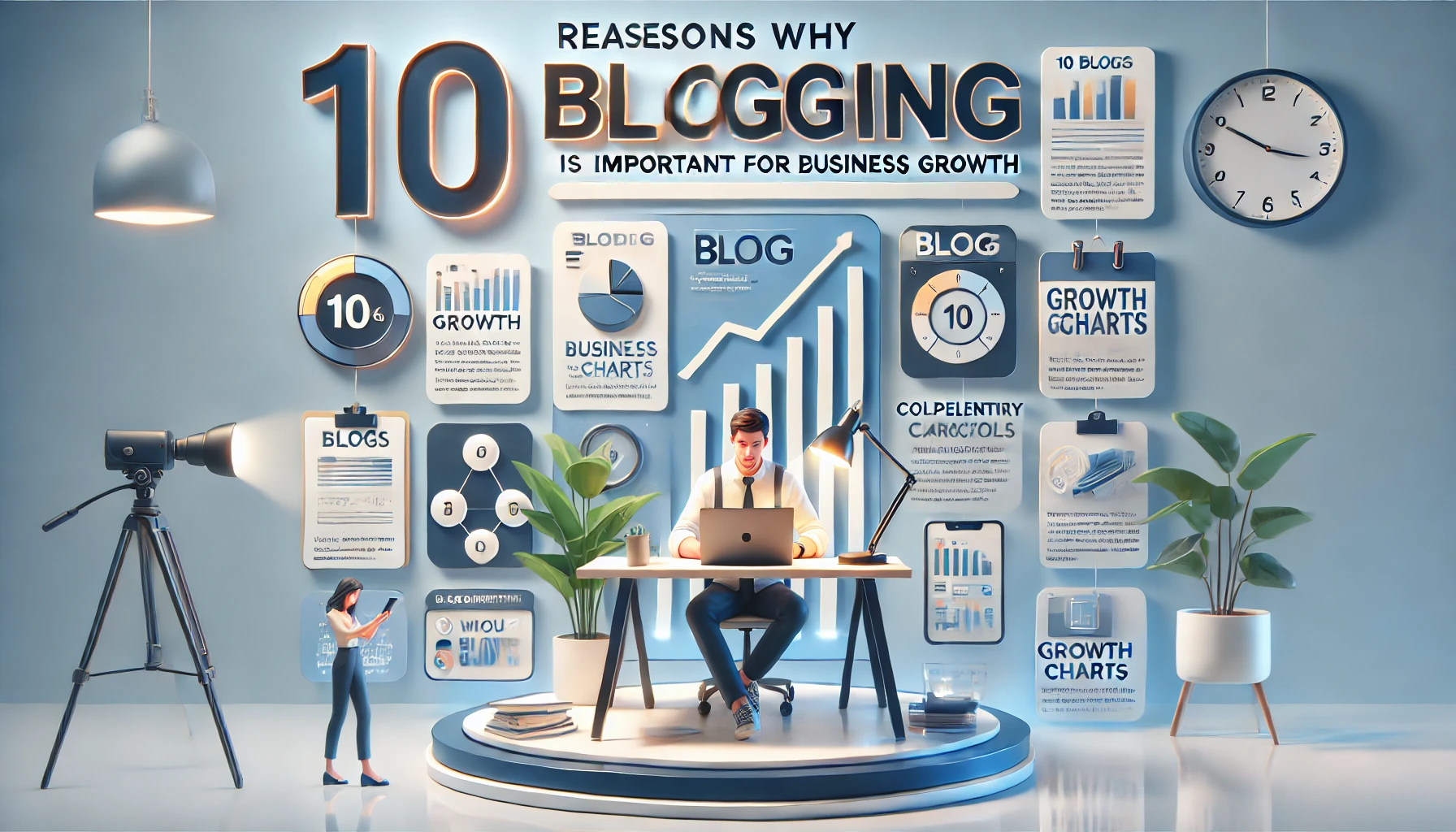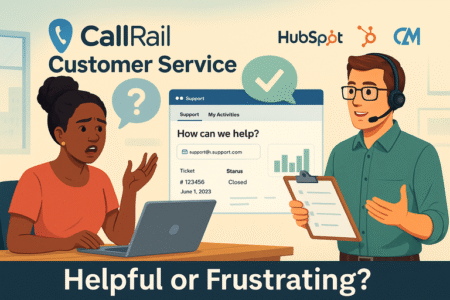Table of Contents
Why blogging is important for business? Have you ever wondered how blogging can transform your business and help it thrive in today’s competitive landscape?
This article will dive deep into the top ten reasons why blogging is a powerful tool for driving business growth and success. From building brand authority to improving customer relationships, each section offers actionable insights.
1. Boosts Your Website’s Organic Traffic
Blogging is a powerhouse for driving organic traffic to your website. When done strategically, it attracts readers who are actively searching for the information or solutions your business offers, leading to increased visibility and sustained audience growth.
How Blogging Increases Search Engine Visibility
Search engines love fresh, relevant, and well-structured content. Blogging allows you to target queries your audience is searching for, positioning your site as a valuable resource. Over time, this boosts your site’s rankings and makes it easier for potential customers to find you.
Creating content that answers specific questions increases your website’s authority. I recommend researching trending topics in your industry and addressing them in detail. The more relevant your content is, the more likely search engines are to rank your blog posts higher.
Engaging titles and meta descriptions play a critical role too. These elements encourage clicks and drive traffic to your blog. I suggest optimizing these areas by including the focus keyword naturally. This small step can significantly improve your search engine visibility.
Consistency is key. Regularly updating your blog signals search engines that your site remains active and valuable. I advise setting up a content calendar to maintain a steady publishing schedule. Doing so ensures your site remains relevant in search results.
Role of Keywords in Attracting Targeted Traffic
Keywords are the bridge between your content and your target audience. Incorporating well-researched keywords into your blog ensures your posts align with what potential customers are searching for. This precision drives more qualified traffic to your website.
To identify effective keywords, I recommend using tools like Google Keyword Planner. Once you’ve identified them, weave them seamlessly into your content. Avoid overloading your blog with keywords, as it can hinder readability and hurt your SEO.
I believe keyword placement in headings, subheadings, and the body text is crucial. This approach helps search engines understand your content’s purpose. Focus on natural integration, prioritizing user experience over keyword density.
Keywords also enhance your blog’s ability to rank for long-tail searches. These are often more specific and reflect a reader’s intent. By targeting long-tail keywords, your blog can attract highly engaged users who are more likely to convert.
Regular Content Updates for Higher Search Rankings
Keeping your blog updated is an effective way to maintain high search rankings. Search engines prioritize fresh content, and revisiting older posts with new insights or updates can give them a second life, boosting their performance.
Start by reviewing blog analytics to identify posts that need updates. I suggest adding new data, examples, or strategies to keep the information relevant and helpful. This proactive approach can significantly improve search rankings and audience retention.
Updated content can also include trending topics. Aligning your blog with current industry trends ensures it remains a go-to resource for your readers. Regular updates demonstrate your commitment to providing value.
Updating doesn’t mean overhauling every time. Sometimes, simple adjustments, like refining headings or enhancing readability, make a big difference. I recommend focusing on user feedback or comments to prioritize areas that need improvement.
2. Establishes Your Brand as an Industry Leader

Blogging is an excellent way to establish credibility in your field. Thoughtful, in-depth posts showcase your expertise and make readers view your brand as a trusted authority. This trust is key to long-term business growth and loyal relationships.
How Quality Content Builds Credibility
High-quality content demonstrates your deep understanding of your industry. Readers gravitate toward blogs that offer genuine insights, actionable tips, and unique perspectives, helping you stand out from competitors and gain their trust.
I suggest focusing on problem-solving topics. Addressing challenges your audience faces positions you as a helpful guide. It’s not just about what you write but how you present it—clear, engaging writing fosters credibility.
Using statistics and reliable sources enhances your content’s credibility. Readers are more likely to trust posts that provide evidence-backed information. Incorporate these elements naturally to strengthen your arguments and boost trust.
Visuals like charts or infographics also enhance the quality of your blogs. They simplify complex ideas and improve user experience. Adding these elements demonstrates your attention to detail and commitment to value-driven content.
Sharing Expertise Through Informative Blogs
Informative blogs act as a showcase for your knowledge. By diving into industry-specific topics, you position yourself as a thought leader. Readers who see your expertise are more likely to trust your brand and recommend your services.
I recommend exploring topics your competitors overlook. These can be niche or highly specific issues your audience struggles with. Addressing such gaps allows you to differentiate your brand and capture attention.
Writing blogs that educate your audience strengthens your connection. Readers appreciate businesses that prioritize knowledge sharing over pure promotion. This creates goodwill and keeps your audience returning for more.
Encouraging reader interaction is another strategy. Invite questions or comments at the end of your posts to foster dialogue. Engaging directly with your audience showcases your expertise and builds deeper relationships.
Using Data-Driven Insights to Gain Trust
Data-driven blogs give your content a professional edge. Using verified data strengthens your arguments and convinces readers of your credibility. It shows that your opinions are not just personal but backed by reliable evidence.
Start by incorporating industry studies or surveys into your blogs. I recommend breaking down complex data into digestible points to enhance understanding. Visualizing data through graphs makes it even more impactful.
Readers are drawn to blogs that provide actionable takeaways. Use data to suggest strategies or predict trends. This forward-thinking approach helps readers plan effectively, further boosting your credibility as a trusted source.
Cite your sources transparently. I believe proper attribution not only reinforces your credibility but also helps you build relationships with other experts in your industry. Collaboration can further enhance your brand’s authority.
3. Strengthens Customer Engagement and Loyalty
Blogging creates meaningful connections that keep customers coming back. It allows businesses to engage authentically, addressing customer needs, answering questions, and fostering trust. A consistent and relatable blogging strategy builds long-term relationships that drive loyalty and repeat business.
How Blogging Builds Emotional Connections
Building emotional connections through blogging enhances brand loyalty. I suggest sharing relatable stories or real-life examples in your blogs. This approach helps readers feel understood, making them more likely to trust and connect with your brand.
Stories create a bond. When you share customer success experiences or your journey, you create a narrative readers can connect with emotionally. I believe this form of storytelling fosters loyalty by humanizing your brand.
Authenticity matters. Speak directly to your audience’s struggles and aspirations. A conversational tone resonates more effectively, showing you genuinely care about their needs. This emotional connection often leads to higher customer retention.
I recommend adding personal touches, like addressing readers directly or asking questions. These elements make your blogs feel interactive and relatable, fostering a deeper sense of engagement and loyalty.
Engaging Readers With Interactive Content
Interactive content keeps readers actively engaged. Blogs with quizzes, polls, or interactive visuals captivate attention and encourage participation. I suggest incorporating these elements to create a more immersive experience that keeps your audience invested.
Encourage comments and discussions at the end of your blog posts. Readers enjoy sharing their thoughts or asking questions. Engaging directly with them through replies strengthens the connection and shows you value their input.
Adding call-to-action prompts within the content can guide readers to participate further. I believe action-oriented content helps readers take the next step, whether it’s exploring another post or trying a recommended solution.
Incorporating videos or multimedia elements enhances blog interactivity. Visual aids like tutorials or product demonstrations make content more engaging. I recommend integrating these to offer a richer user experience.
Personalizing Blogs to Reflect Audience Interests
Personalized blogs resonate deeply with readers. Tailoring content to their preferences shows that you understand their unique needs and challenges. I advise conducting surveys or analyzing feedback to create posts that align with audience interests.
Segmentation can make personalization easier. Divide your audience based on demographics or behavior, and create targeted blog posts. This strategy helps deliver content that feels relevant and valuable to different reader groups.
Addressing reader-specific problems in your blogs fosters stronger connections. For example, sharing solutions tailored to industry-specific challenges positions your brand as a trusted ally. I recommend exploring niche topics to demonstrate this expertise.
Including reader-generated content or testimonials adds authenticity. I believe highlighting real experiences not only builds trust but also encourages others to engage more deeply with your brand.
4. Provides Long-Term Marketing Value

Blogging is a cost-effective strategy that offers enduring benefits. Unlike short-lived ads, well-crafted blog posts continue to drive traffic and generate leads over time. Consistently investing in blogging ensures sustained visibility and relevance for your business.
Evergreen Content: A Long-Lasting Asset
Evergreen content stays relevant and valuable for years. It addresses timeless topics that consistently attract traffic. I suggest focusing on foundational questions in your industry to create blogs with lasting appeal.
Updating evergreen blogs enhances their longevity. Regularly refreshing facts or statistics keeps the content accurate and reliable. I recommend scheduling periodic reviews to ensure your posts remain useful and relevant.
Optimized evergreen posts become a consistent traffic source. These blogs rank well in search engines, bringing steady visibility. I believe this ongoing exposure is invaluable for long-term brand growth.
Evergreen content builds authority over time. Readers view your blog as a reliable resource, strengthening trust in your brand. Crafting insightful, enduring content demonstrates your commitment to providing value.
Reducing Marketing Costs With Blogs
Blogging is a budget-friendly marketing tool. Creating and maintaining blogs costs significantly less than many advertising methods. I suggest leveraging this advantage to achieve a strong ROI for your business.
Blogs generate leads without recurring expenses. A single post can continue to attract and convert readers for months or years. This long-term benefit makes blogging a smart investment compared to paid ads.
Reusing blogs across platforms extends their value. Share posts on social media or email campaigns to reach a wider audience without additional costs. I believe this multi-channel approach maximizes your blog’s impact.
High-quality blogs reduce dependency on paid promotions. By driving organic traffic, they cut down on advertising costs while delivering comparable results. I recommend focusing on SEO to amplify this effect.
How Blogs Outperform Paid Advertising
Blogs often outperform ads in terms of longevity and cost-effectiveness. While ads stop generating results once the budget runs out, blog content continues to deliver value over time. This makes blogging a sustainable alternative.
Readers trust blogs more than ads. Informative posts build credibility and encourage engagement. I believe investing in well-researched content is more impactful than relying solely on promotional materials.
Blogs allow for detailed storytelling. Unlike ads, they provide the space to delve into topics, educating and inspiring readers. This deeper connection fosters loyalty, which I suggest prioritizing in your strategy.
Search engines favor organic content over ads. Blogging boosts your site’s rankings, ensuring consistent visibility without paying for clicks. This advantage makes blogs a superior long-term marketing asset.
5. Enhances Social Media Marketing Efforts
Blogging and social media go hand in hand to amplify your marketing strategy. Blogs provide valuable content that sparks interest, encourages engagement, and drives traffic to your site when shared across social platforms.
How Blogs Act as Shareable Content for Social Media
Blogs are an endless source of shareable content for your social media. They offer insights and information that your audience can easily engage with, making it simple to fill your feeds with valuable and relevant posts.
Sharing blog snippets on social platforms drives curiosity. I suggest pulling compelling quotes, statistics, or visuals from your blogs to create posts that encourage clicks. This approach entices followers to visit your site for more details.
I advise crafting blog headlines that capture attention. A catchy title or intriguing question can spark conversations and sharing, helping your content reach a wider audience organically. This simple strategy boosts social engagement.
Repurposing blogs into bite-sized formats extends their reach. Turn longer posts into quick tips, infographics, or videos for platforms like Instagram or TikTok. I believe this makes your content more versatile and appealing.
Increasing Social Reach With Blog Promotions
Promoting blogs on social media enhances visibility. Sharing blog links with your followers not only drives traffic but also provides a way to engage with new audiences who may find your posts through shares or recommendations.
Consistent sharing is key. I suggest using a content calendar to schedule blog promotions regularly. This ensures your content stays fresh in your audience’s minds and reaches different users at optimal times.
I recommend using hashtags and tags strategically. Incorporating trending topics or tagging relevant influencers can increase your blog’s discoverability. This approach helps your content gain momentum on social platforms.
Encouraging followers to share your blog posts expands reach significantly. You can even offer incentives, like exclusive discounts or entries to contests, for those who spread the word about your content.
Encouraging User-Generated Content Through Blogging
Blogs inspire user-generated content, which enhances authenticity. By inviting readers to share their experiences, insights, or creations related to your blog topics, you create a community-driven content cycle that boosts trust and engagement.
Readers love being part of the conversation. I suggest prompting them with open-ended questions or challenges at the end of your posts. Their responses often spark lively interactions and add value to your brand.
Featuring user contributions in future blogs fosters connection. Highlighting testimonials, stories, or creative content submitted by your audience makes them feel valued. I believe this builds loyalty and strengthens your brand’s reputation.
Collaborative blogging opportunities also work wonders. Partner with customers or influencers to co-create content. This not only diversifies your blog but also helps attract new audiences who follow your collaborators.
6. Improves Lead Generation and Conversions

Blogging is a powerful tool for generating leads and increasing conversions. Thoughtful posts attract readers, address their needs, and guide them through your sales funnel, turning casual visitors into loyal customers.
Using Blogging for Effective Lead Magnet Strategies
Blogging complements lead magnet strategies by providing value upfront. Offering free, downloadable resources, like eBooks or checklists, within your blogs encourages readers to share their contact information, turning them into leads.
I suggest focusing on topics that align with your lead magnets. For instance, a blog about budgeting tips can offer a free budgeting template as a download. This synergy increases the appeal of your lead magnets.
Position your lead magnet as a solution to a problem. Highlighting its benefits within the context of your blog makes readers more likely to engage. I believe this approach keeps the offer relevant and enticing.
Create clear, actionable steps for readers to claim the lead magnet. A simple process, such as entering an email address, reduces friction and improves your conversion rates, turning blog traffic into tangible leads.
Crafting CTAs That Convert Through Blogs
Effective calls-to-action (CTAs) within blogs drive conversions. A well-placed CTA guides readers toward taking the next step, whether it’s subscribing, purchasing, or contacting your business for more information.
I recommend keeping CTAs specific and action-oriented. Instead of generic phrases like “Click Here,” try “Download Your Free Guide Now.” This clarity helps readers understand exactly what they’re getting and motivates action.
Incorporating CTAs naturally within the content is crucial. I advise placing them where they feel like a logical next step, such as after providing valuable insights or solutions to a reader’s challenge.
Using visuals for CTAs increases their effectiveness. Buttons or highlighted text catch attention and improve click-through rates. I suggest experimenting with placement and design to find what resonates best with your audience.
Aligning Blog Content With Sales Funnels
Blogs play a critical role in guiding readers through your sales funnel. They attract top-of-funnel traffic, nurture interest mid-funnel, and drive conversions at the bottom by addressing specific stages of the customer journey.
I advise creating blog posts tailored to each funnel stage. For example, educational posts attract awareness-stage readers, while detailed comparisons or case studies appeal to those ready to buy.
Linking related blogs keeps readers engaged longer. I suggest using internal links to direct readers to posts that address the next stage of their journey, keeping them within your sales funnel seamlessly.
Personalizing blogs for different buyer personas enhances effectiveness. Understanding your audience’s unique needs allows you to craft content that resonates and aligns perfectly with their decision-making process.
7. Builds a Stronger Relationship With Customers
Blogging fosters stronger customer relationships by addressing their questions, building trust, and creating meaningful connections. It’s an opportunity to showcase your commitment to understanding and solving their needs.
Using Blogging to Answer Customer Questions
Answering customer questions through blogs builds trust. Readers appreciate content that addresses their concerns or clarifies doubts. I suggest compiling common queries and turning them into in-depth blog posts to demonstrate expertise.
Being proactive with FAQs enhances customer satisfaction. Anticipating their needs and offering solutions through your blogs shows care and attention, which strengthens your bond with them.
Engaging readers with how-to guides or tutorials is another effective strategy. These posts provide actionable advice that helps solve their problems, making your brand a go-to resource.
I recommend inviting readers to ask new questions in your blog comments. This keeps the content dynamic and opens the door for further engagement and trust-building opportunities.
Building Transparency Through Informative Posts
Transparency fosters trust, and blogs are the perfect platform for it. Sharing behind-the-scenes insights, business processes, or even challenges creates an honest connection with your audience.
I suggest using blogs to explain complex topics in simple terms. When customers feel informed, they’re more likely to trust your brand and rely on your expertise.
Addressing mistakes openly in your blogs shows accountability. I believe this builds credibility and strengthens relationships with readers who value honesty over perfection.
Incorporating customer feedback into blogs demonstrates that you’re listening. Highlighting how you’ve addressed concerns or implemented suggestions enhances transparency and fosters loyalty.
Strengthening Brand Loyalty With Engaging Stories
Engaging storytelling deepens emotional connections. Sharing stories about your brand’s journey, values, or successes resonates with readers and makes your content memorable, fostering long-term loyalty.
I recommend weaving customer success stories into your blogs. Highlighting how your products or services have made a difference adds authenticity and inspires trust in your brand.
Stories about your team or milestones create a sense of community. Readers love learning about the faces behind the brand. I believe this human touch strengthens your relationship with them.
Ending blogs with a personal note or relatable message leaves a lasting impression. This thoughtful approach keeps readers coming back, ensuring your content is not just informative but emotionally compelling.
8. Offers Insights Into Audience Preferences

Blogging provides valuable insights into your audience’s behavior and preferences. By analyzing engagement metrics and feedback, you can refine your content strategy to better meet your readers’ needs and build stronger connections.
Tracking Blog Metrics to Understand Readers
Metrics are a window into your readers’ minds. Tracking key performance indicators like page views, bounce rates, and time on page helps you understand which topics resonate most and where improvements are needed.
Analyze your most-viewed posts to identify trending interests. I recommend focusing on high-performing topics and creating similar content to keep your audience engaged. This strategy ensures your blogs remain relevant and impactful.
Pay attention to the bounce rate. A high bounce rate might indicate content misalignment with reader expectations. I suggest reviewing your headlines and ensuring they match the blog’s actual focus to keep readers interested.
Monitor engagement indicators like shares and comments. These metrics reveal how well your content connects with readers. I believe fostering active discussions in your blogs is a sign of strong audience engagement.
Adapting Content Based on User Feedback
User feedback is a goldmine for improving your blog strategy. Direct input from readers, whether through comments, surveys, or social media, offers actionable insights into what they value most about your content.
I advise including a feedback form or poll within your blog posts. This invites readers to share their thoughts easily, helping you gather useful data to refine your content direction.
Responding to comments builds rapport and clarifies content-related questions. When readers see their input acknowledged, they feel more connected to your brand. I suggest making this a regular practice.
Incorporating feedback into future blogs demonstrates responsiveness. If readers request more tutorials, for instance, delivering them shows you’re listening. This strengthens trust and loyalty over time.
Using Blogs to Identify Market Trends
Blogs are excellent tools for spotting market trends. By analyzing audience interactions and emerging topics, you can align your business with the latest industry developments and better serve your customers.
Track trending keywords within your blog analytics. I recommend using these insights to identify shifts in customer interests and adapting your content to stay ahead of these trends.
Engage with comments and questions to uncover new topics. Readers often bring up challenges or ideas you might not have considered. I believe responding thoughtfully opens doors to innovative blog themes.
Observe sharing patterns. Topics that go viral often hint at broader interests or concerns in your niche. Use this data to create follow-up content that delves deeper into these areas.
9. Supports Content Repurposing and Multichannel Reach
Blogs are versatile assets that can be repurposed for different platforms and formats. Leveraging this flexibility helps you expand your reach, engage diverse audiences, and maximize the value of your content.
How to Turn Blogs Into Videos and Infographics
Transforming blogs into visual formats enhances engagement. Videos and infographics simplify complex ideas, making them more accessible and shareable for your audience. I suggest prioritizing visual content to expand your blog’s impact.
I recommend creating explainer videos from how-to blogs. These videos can highlight key steps or processes in a concise and engaging way, capturing the attention of visual learners.
Infographics distill dense information into bite-sized visuals. Take data-heavy blogs and transform them into colorful, easy-to-read graphics that your audience can share across social platforms.
Video snippets and infographics also increase your reach on visual-heavy platforms like Instagram and Pinterest. This approach ensures your content appeals to a broader audience without starting from scratch.
Expanding Blog Reach Through Email Newsletters
Email newsletters are a great way to distribute your blog content. Sharing summaries or teasers with a link back to the full post drives traffic and keeps your subscribers engaged with your brand.
Craft compelling subject lines for your newsletters. I believe attention-grabbing headlines encourage recipients to open your emails, increasing click-through rates to your blogs.
Include personalized recommendations. If your subscriber has shown interest in a specific topic, suggesting related blogs enhances their experience and makes your email feel tailored.
Segmenting your audience boosts relevance. I suggest dividing your subscribers based on their interests or preferences and sending targeted newsletters with curated blog content.
Repurposing Blogs for Podcasts and Webinars
Turning blogs into podcasts or webinars diversifies your content offering. These formats engage audiences who prefer audio or interactive experiences, broadening your reach and deepening connections with your audience.
Repurpose educational blogs as podcast episodes. I recommend creating a conversational tone that brings the topic to life and allows listeners to absorb valuable insights while on the go.
Webinars provide an interactive element. Expanding on blog topics in a live format lets you answer questions and connect directly with your audience. This personal engagement builds trust and rapport.
I suggest combining blogs into themed podcast series. For instance, a series on “lead generation tips” could offer ongoing value and encourage listeners to explore related content on your blog.
10. Keeps Your Business Relevant in the Digital Era

Blogging ensures your business stays relevant by addressing evolving customer needs, tracking industry shifts, and maintaining consistent communication. It’s a dynamic tool for adaptability and long-term success.
Staying Ahead of Competitors With Fresh Content
Fresh content keeps you competitive. Regularly publishing blogs on trending topics or innovative ideas establishes your brand as a forward-thinking leader in your industry.
I recommend monitoring competitors’ blogs to identify gaps in their content. Addressing these gaps sets your brand apart and attracts readers looking for comprehensive insights.
Publishing timely blogs enhances your authority. For example, addressing industry changes or new regulations demonstrates expertise and a commitment to keeping your audience informed.
Experiment with new formats or approaches. I believe stepping outside conventional blogging styles, like incorporating multimedia or storytelling, keeps your content fresh and engaging.
How Blogging Adapts to Changing Consumer Needs
Blogging offers flexibility to address shifting consumer preferences. By observing reader behavior and feedback, you can quickly pivot your content strategy to remain aligned with their expectations.
I suggest regularly surveying your audience to understand their evolving needs. Use this data to guide your blog topics and maintain relevance.
Incorporate current events or trends into your posts. Connecting your content with what’s happening in the world helps your blog feel timely and relatable.
Highlighting innovations or solutions that address new challenges keeps your blog valuable. This adaptability shows your commitment to meeting your audience’s needs as they evolve.
Ensuring Consistency in Brand Messaging
Consistency in your blogs reinforces brand identity. A unified tone, style, and messaging across all posts create a cohesive reader experience, building trust and recognition over time.
Develop clear content guidelines. I recommend defining your brand’s voice, core values, and visual elements to ensure every blog aligns with your identity.
Align your blogs with overarching business goals. For instance, if your focus is sustainability, ensure your content reflects this commitment. This consistency strengthens your positioning in the market.
Revisit older posts to update tone and messaging if necessary. I believe keeping your entire blog archive aligned with current branding ensures a seamless experience for new and returning readers.






